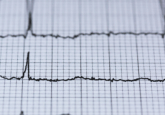Scientists use shopping carts to diagnose atrial fibrillation

Researchers have conducted a study where they embedded electrocardiogram sensors in the handles of shopping carts to identify people with atrial fibrillation.
In a new study carried out by researchers at Liverpool John Moores University (UK), electrocardiogram sensors were embedded into the handles of 10 shopping carts. The carts were then used across four grocery stores with pharmacies in Liverpool (UK) to test if shoppers had atrial fibrillation, a heart rhythm disorder that makes the risk of a stroke five times greater. The findings of this study were presented at the Association of Cardiovascular Nursing & Allied Professions meeting 2023 (23–24 June 2023; Edinburgh, UK).
Atrial fibrillation is the most common heart rhythm disorder, with over 40 million people in the world having the condition. However, despite its high occurrence, many people only realize they have the disorder after they suffer from a stroke. Therefore, screening programs are needed to identify those with the condition so they can receive preventive medication.
In the study, which was conducted over a 2-month period, shoppers were asked to use the modified cart and hold the handlebar for at least 60 seconds. If the handlebar lit up green, then it indicated that no irregular heartbeat was found, which was confirmed by a manual pulse check by a researcher. However, if atrial fibrillation was detected, the handlebar would light up red and an in-store pharmacist would do a manual pulse check and another sensor reading using a sensor not attached to a cart. Study cardiologists would review the results of the participants with red lights and would inform them of their results. The three possible results were: no atrial fibrillation, an unclear result with an invitation to repeat the measurement or atrial fibrillation confirmed along with a cardiologist appointment in 2 weeks.
 Three advances in stem-cell-derived cardiac models and therapies
Three advances in stem-cell-derived cardiac models and therapies
Aisha Al-Janabi, our Content Editor, explores recent cardiovascular disease research, including developing heart organoids with vascular cells, launching cardiac chips to the International Space Station (ISS) and using stem-cell therapy to repair damaged heart muscle.
During the 2-month period, 2155 adults used the shopping cart and of those people, 220 had either a red light or an irregular pulse. After the ECG review by the cardiologists, there was no evidence of atrial fibrillation in 115 shoppers, there were 46 unclear cases and 59 people were diagnosed. Of the 59 people diagnosed, 20 had prior knowledge of their condition and 39 were unaware.
“This study shows the potential of taking health checks to the masses without disrupting daily routines. Over the course of two months, we identified 39 patients who were unaware that they had atrial fibrillation. That is 39 people at greater risk of stroke who received a cardiologist appointment,” commented co-author Ian Jones.
Analysis of the results showed that the sensor’s sensitivity ranged from 0.70–0.93 while the specificity ranged from 0.15–0.97. This resulted in a positive predictive value of 0.24–0.56 and a negative predictive value of 0.55–1.00, meaning there was a high number of both false positives and false negatives.
While adjustments need to be made to make the system more accurate, the strategy could be an easily implemented way of diagnosing atrial fibrillation. “Checking for atrial fibrillation while people do their regular shopping holds promise for preventing strokes and saving lives. A crucial aspect is providing immediate access to a health professional who can explain the findings and refer patients on for confirmatory tests and medication if needed,” commented Jones.


